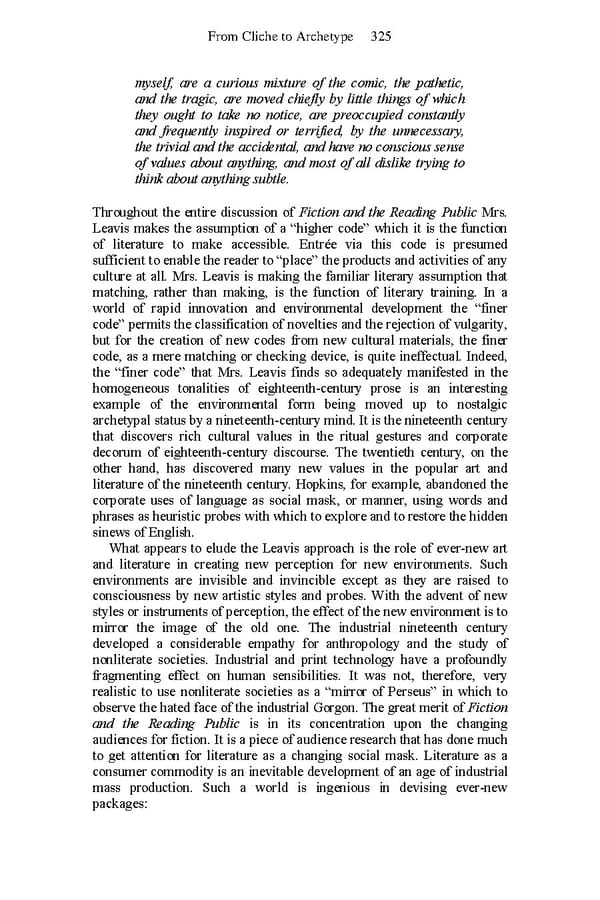From Cliche to Archetype 325 myself, are a curious mixture of the comic, the pathetic, and the tragic, are moved chiefly by little things of which they ought to take no notice, are preoccupied constantly and frequently inspired or terrified, by the unnecessary, the trivial and the accidental, and have no conscious sense of values about anything, and most of all dislike trying to think about anything subtle. Throughout the entire discussion of Fiction and the Reading Public Mrs. Leavis makes the assumption of a “higher code” which it is the function of literature to make accessible. Entrée via this code is presumed sufficient to enable the reader to “place” the products and activities of any culture at all. Mrs. Leavis is making the familiar literary assumption that matching, rather than making, is the function of literary training. In a world of rapid innovation and environmental development the “finer code” permits the classification of novelties and the rejection of vulgarity, but for the creation of new codes from new cultural materials, the finer code, as a mere matching or checking device, is quite ineffectual. Indeed, the “finer code” that Mrs. Leavis finds so adequately manifested in the homogeneous tonalities of eighteenth-century prose is an interesting example of the environmental form being moved up to nostalgic archetypal status by a nineteenth-century mind. It is the nineteenth century that discovers rich cultural values in the ritual gestures and corporate decorum of eighteenth-century discourse. The twentieth century, on the other hand, has discovered many new values in the popular art and literature of the nineteenth century. Hopkins, for example, abandoned the corporate uses of language as social mask, or manner, using words and phrases as heuristic probes with which to explore and to restore the hidden sinews of English. What appears to elude the Leavis approach is the role of ever-new art and literature in creating new perception for new environments. Such environments are invisible and invincible except as they are raised to consciousness by new artistic styles and probes. With the advent of new styles or instruments of perception, the effect of the new environment is to mirror the image of the old one. The industrial nineteenth century developed a considerable empathy for anthropology and the study of nonliterate societies. Industrial and print technology have a profoundly fragmenting effect on human sensibilities. It was not, therefore, very realistic to use nonliterate societies as a “mirror of Perseus” in which to observe the hated face of the industrial Gorgon. The great merit of Fiction and the Reading Public is in its concentration upon the changing audiences for fiction. It is a piece of audience research that has done much to get attention for literature as a changing social mask. Literature as a consumer commodity is an inevitable development of an age of industrial mass production. Such a world is ingenious in devising ever-new packages:
 Essential McLuhan Page 331 Page 333
Essential McLuhan Page 331 Page 333